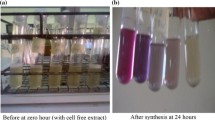Abstract
In this article, industrially useful bacteria Bacillus megaterium (MTCC 2444) have been explored in the biosynthesis of gold nanoparticles for the first time. Different parameters including pH, temperature, biomass concentration have been studied for optimization of nanoparticle synthesis. Characterizations of nanoparticles have been carried out by UV–Vis spectroscopy, XRD, FTIR and HRTEM. The average size of the nanoparticles is found to be around 16 nm. Mechanistic studies indicate that a flavin-containing reductase is possibly involved in the biosynthesis process. To the best of our knowledge, this is for the first time the participation of flavin-containing reductase domain of cytochrome P450 BM3 of B. megaterium is demonstrated in the biosynthesis of nanoparticles. Extracellular biosynthesis of gold nanoparticles has also been demonstrated by using the cell-free-extract of bacterial biomass. Moreover, biosynthesized gold nanoparticles exhibit wide spectrum of antimicrobial activities against several multidrug resistant pathogenic bacteria.











Similar content being viewed by others
References
T. Xia, M. Kovochich, M. Liong, L. Madler, B. Gilbert, H. Shi, J. I. Yeh, J. I. Zink, and A. E. Nel (2008). ACS Nano 2, 2121.
N. G. K. L. A. Dykman (2011). Acta Nat. 03, 22.
K. Weintraub (2013). Nature 495, S14.
G. Southam and T. J. Beveridge (1996). Geochimica et Cosmochimica Acta 60, 4369.
B. Nair and T. Pradeep (2002). Cryst. Growth Design 2, 293.
S. He, Z. Guo, Y. Zhang, S. Zhang, J. Wang, and N. Gu (2007). Mater. Lett. 61, 3984.
P. Gwynne (2013). Nature 495, S12.
P. Mukherjee, S. Senapati, D. Mandal, A. Ahmad, M. I. Khan, R. Kumar, and M. Sastry (2002). ChemBioChem 3, 461.
A. Chauhan, S. Zubair, S. Tufail, A. Sherwani, M. Sajid, S. C. Raman, A. Azam, and M. Owais (2011). Int. J. Nanomed. 6, 2305.
M. I. Husseiny, M. A. El-Aziz, Y. Badr, and M. A. Mahmoud (2007). Spectrochimica Acta A 67, 1003.
T. J. Beveridge and R. G. Murray (1980). J. Bacteriol. 141, 876.
P. S. Vary, R. Biedendieck, T. Fuerch, F. Meinhardt, M. Rohde, W. D. Deckwer, and D. Jahn (2007). Appl. Microbiol. Biotechnol. 76, 957.
M. Saravanan, A. K. Vemu, and S. K. Barik (2011). Colloids Surf. B 88, 325.
Institute CaLS (2012) Methods for dilution antimicrobial susceptibility testing for bacteria that grow aerobically. Approved Standard M07-A9.
R. J. Lambert and J. Pearson (2000). J. Appl. Microbiol. 88, 784.
U. K. Laemmli (1970). Nature 227, 680.
A. M. Clemments, C. Muniesa, C. C. Landry, and P. Botella (2014). RSC Adv. 4, 29134.
K. Kalishwaralal, V. Deepak, S. R. K. Pandian, and S. Gurunathan (2009). Bioresour. Technol. 100, 5356.
A. Moores and F. Goettmann (2006). New J. Chem. 30, 1121.
A. V. Zayats (2013). Nature 495, S7.
S. H. Park, J. Y. Kang, D. H. Kim, T. Ahn, and C. H. Yun (2012). Biomol. Ther. 20, 562.
Y. Cui, Y. Zhao, Y. Tian, W. Zhang, X. Lu, and X. Jiang (2012). Biomaterials 33, 2327.
Author information
Authors and Affiliations
Corresponding author
Rights and permissions
About this article
Cite this article
Jena, S., Das, B., Bosu, R. et al. Bacteria Generated Antibacterial Gold Nanoparticles and Potential Mechanistic Insight. J Clust Sci 26, 1707–1721 (2015). https://doi.org/10.1007/s10876-015-0869-7
Received:
Published:
Issue Date:
DOI: https://doi.org/10.1007/s10876-015-0869-7




